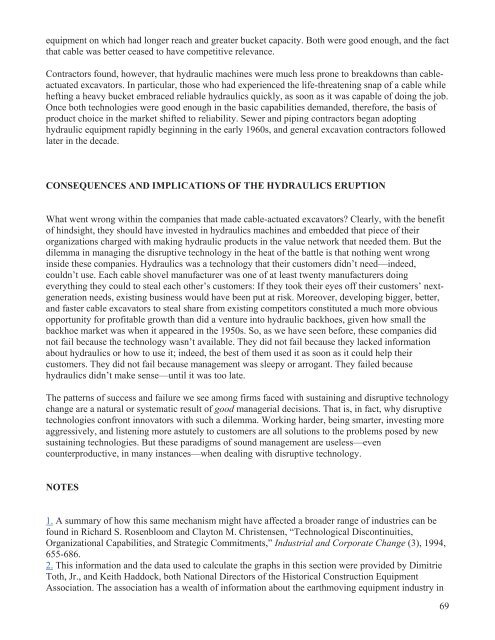PRUEBAS
PRUEBAS
PRUEBAS
Create successful ePaper yourself
Turn your PDF publications into a flip-book with our unique Google optimized e-Paper software.
equipment on which had longer reach and greater bucket capacity. Both were good enough, and the factthat cable was better ceased to have competitive relevance.Contractors found, however, that hydraulic machines were much less prone to breakdowns than cableactuatedexcavators. In particular, those who had experienced the life-threatening snap of a cable whilehefting a heavy bucket embraced reliable hydraulics quickly, as soon as it was capable of doing the job.Once both technologies were good enough in the basic capabilities demanded, therefore, the basis ofproduct choice in the market shifted to reliability. Sewer and piping contractors began adoptinghydraulic equipment rapidly beginning in the early 1960s, and general excavation contractors followedlater in the decade.CONSEQUENCES AND IMPLICATIONS OF THE HYDRAULICS ERUPTIONWhat went wrong within the companies that made cable-actuated excavators? Clearly, with the benefitof hindsight, they should have invested in hydraulics machines and embedded that piece of theirorganizations charged with making hydraulic products in the value network that needed them. But thedilemma in managing the disruptive technology in the heat of the battle is that nothing went wronginside these companies. Hydraulics was a technology that their customers didn’t need—indeed,couldn’t use. Each cable shovel manufacturer was one of at least twenty manufacturers doingeverything they could to steal each other’s customers: If they took their eyes off their customers’ nextgenerationneeds, existing business would have been put at risk. Moreover, developing bigger, better,and faster cable excavators to steal share from existing competitors constituted a much more obviousopportunity for profitable growth than did a venture into hydraulic backhoes, given how small thebackhoe market was when it appeared in the 1950s. So, as we have seen before, these companies didnot fail because the technology wasn’t available. They did not fail because they lacked informationabout hydraulics or how to use it; indeed, the best of them used it as soon as it could help theircustomers. They did not fail because management was sleepy or arrogant. They failed becausehydraulics didn’t make sense—until it was too late.The patterns of success and failure we see among firms faced with sustaining and disruptive technologychange are a natural or systematic result of good managerial decisions. That is, in fact, why disruptivetechnologies confront innovators with such a dilemma. Working harder, being smarter, investing moreaggressively, and listening more astutely to customers are all solutions to the problems posed by newsustaining technologies. But these paradigms of sound management are useless—evencounterproductive, in many instances—when dealing with disruptive technology.NOTES1. A summary of how this same mechanism might have affected a broader range of industries can befound in Richard S. Rosenbloom and Clayton M. Christensen, “Technological Discontinuities,Organizational Capabilities, and Strategic Commitments,” Industrial and Corporate Change (3), 1994,655-686.2. This information and the data used to calculate the graphs in this section were provided by DimitrieToth, Jr., and Keith Haddock, both National Directors of the Historical Construction EquipmentAssociation. The association has a wealth of information about the earthmoving equipment industry in69


